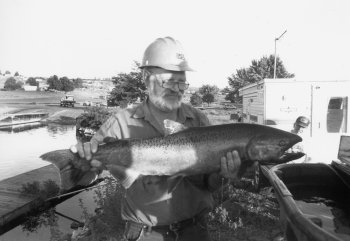forum
library
tutorial
contact

Upriver Run Gets Late Boost;
Snake Fish may Set Record
by Bill Rudolph
NW Fishletter, September 21, 2004
|
the film forum library tutorial contact |

|
Upriver Run Gets Late Boost;
by Bill Rudolph
|
 Taking note of a big Sept. 14 spike in adult returns at Bonneville Dam, official fish prognosticators bumped up their estimate of the fall chinook return twice in five days.
Taking note of a big Sept. 14 spike in adult returns at Bonneville Dam, official fish prognosticators bumped up their estimate of the fall chinook return twice in five days.
With daily fish numbers rising from about 20,000 a day to 35,000-fish a day on the 14th, the season total reached 484,000 fish by Sept. 20 for the upriver run, with about 65 percent in the bright category, and the rest tules headed for Bonneville Pool.
Fish managers raised their overall forecast (to Columbia River mouth) from 635,000 to 702,000 fish, which includes fall stocks returning to areas below Bonneville Dam.
Though they stayed with a preseason estimate for wild Snake River fall chinook (6,100 to Columbia River mouth), wild and hatchery numbers combined are running comparatively high in the lower Snake. With about 42 percent of the fall run estimated to have passed Lower Granite Dam, the fall count stands at 8,452 fish, nearly four times the 10-year average. Last year, about 12,000 hatchery and wild fish were counted, with about one-third of them estimated to be wild.
At present, over 500 fish/day are being counted at Lower Granite. That's more fish than were seen during the entire fall seasons of some years since 1976, when the dam, the last of four projects on the lower part of the river, was completed.
Managers estimated that about 80 percent of the upriver run had passed Bonneville Dam, with the escapement goal for fall chinook at McNary Dam topped for the 21st consecutive year. So far, numbers there are about two and one-half times the 43,500-fish goal, with the University of Washington's in-season forecaster estimating that about 72 percent of the upriver run has made it beyond McNary, most headed for the vaunted, and lately crowded, Hanford Reach spawning grounds.
But state and tribal fish managers say steelhead numbers are less than anticipated, with both early and late runs nearly 30 percent below predictions. Tribes reported Sept. 16 that they had caught nearly 81,000 fall chinook, with nearly 29,000 estimated to be upriver brights. They proposed another four days fishing from Sept. 20 to Sept. 24.
They had pegged their projected impact to date at only about 9 percent out of an allowable 23 percent of the upriver bright run. The tribes had also caught about 13,000 steelhead, and projected an 8.2 percent harvest on the wild listed 'B' steelhead run headed for Idaho out of an allowed 15-percent allowable impact.
This year, most tribal harvesters were netting above John Day Dam to waylay a larger percentage of more valuable upriver brights and catch fewer low-value tules headed mainly for the Spring Creek hatchery in Bonneville Pool. The tules fetch much lower prices because they are nearly ready to spawn.
Lower Columbia sports fishermen don't like to keep tules, either. Many tules were reported floating among the sports fleet, after sporties had unhooked them in the Buoy 10 fishery, where chinook were not allowed to be retained after Sept. 7. By then, sporties had landed 16,100 chinook and 14,400 coho. The sports fishery for chinook and coho is still open above the Buoy 10 area all the way up the Columbia to above Pasco.
Commercial gillnetters in the lower Columbia caught more than 11,000 chinook in August, about two-thirds brights and one-third tules. Earlier this month, they began their select area fishery, targeting local hatchery returns in the lower river to keep from impacting listed upriver stocks.
learn more on topics covered in the film
see the video
read the script
learn the songs
discussion forum
